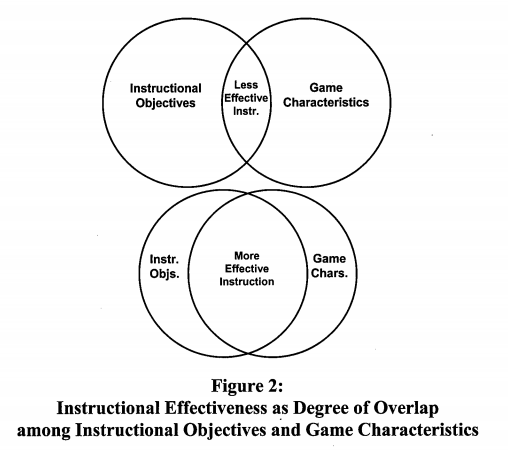L&D lessons from learning games research


Gamification and learning games are a popular way to make workplace learning more engaging, but what makes an effective learning game?
Studies have been carried out into many different areas of learning games. Some of the most useful reports are meta analyses of different studies that reveal the trends common to all the games research.
Research into learning games
Robert T. Hays set out to find evidence of the effectiveness of learning games by analysing articles on the practice. In 2005 he looked at 105 articles on learning games on behalf of the Naval Air Warfare Center Trainings Systems Division.
Throughout the report Hays confirms that having instructional design input into a game is critical to making it successful. He says: “Games can be of instructional value if they are well designed and targeted to meet specific instructional objectives.”
He found that the more overlap between learning objectives and game characteristics, the more effective the learning game is. The results of his games research can be summed up in this diagram:

It seems like a common sense rule but several of the examples he analysed involve no instructional design, relying on games or graphics designers alone to create the game.
In the conclusion of his report he presents some advice for L&D teams who are going to be producing learning games for industry:
- Undertake a detailed analysis of the learning requirements before deciding whether to create a learning game or use an alternative
- L&D teams should insist that learning game developers demonstrate how the design of a game will support the learning objectives
- Online learning games should include performance evaluation, debriefing, and feedback
Since the report was published there have been huge advances in the technology required to create interactions like games. This has had the effect of making it easier for learning designers to take on a game project, but not always to make the most of the opportunities.
One way to make sure your games focus on the learning objectives and make good use of game thinking is to ensure they’re created by a combination of experienced learning designers and games developers.
To help teams work together to create the most effective game he offers some specific tips on the different elements that make up a learning game.
Game elements
One of the most useful parts of the report’s conclusions deals with specific types of games and the best way to approach them. There are many tips which are useful for game and learning designers and some that will help L&D professionals who are adding games to their learning strategy.
- Feedback should be provided throughout the game to highlight any areas of knowledge that are lacking
- A learning game works best as part of a larger course
- Learners should have a chance for deeper feedback after the game to understand how it supports learning objectives
The main theme of higher level tips is feedback. Much of the research into games effectiveness highlights that games shouldn’t be used for everything and should always be part of a wider training programme.
When you’re working with a learning game design team factor in time to make sure the game fits with the rest of the learning. When a game is part of a learning course it’s important to make the look and feel consistent to avoid confusing learners.
Feedback is usually provided in real time in the game itself and can be very effective at highlighting areas that a learner needs to work on. L&D teams can help ensure the best results by also having a debrief after the game so participants can talk about what they’ve learned and taken away from the experience.
Games vs traditional approaches
Traci Sitzmann and her colleagues at the University of Colorado analysed 65 studies into the effectiveness of games in training for adults.
Describing the studies Sitzmann said:
“Trainees in the comparison group either received alternative instructional methods (conducting a lab experiment or completing an assignment) as a substitute for the game, or conversely, the game was used as a supplement to the instruction that both groups received, and the comparison group did not receive any supplemental instruction”
The headline figures from the research showed that learners benefited in different ways from learning games.
- Skill-based knowledge increased by 14%
- Factual knowledge increased by 11%
- Knowledge retention increased by 9%
So the numbers back up the effectiveness of games in different areas. Skill based knowledge fares best, as we might expect from using an interaction that requires similar skills on the part of the learner.
Knowledge retention increasing may be down to a number of factors, but it can certainly be improved by adding elements of spaced practice, something that games lend themselves to very well.
When the results were analysed as a whole there were some findings that are especially useful for learning game designers.
- Games with active instruction are most effective
- Games with passive instruction elements were only as effective as more traditional training methods
If the gameplay features the actions or scenarios that a learner will experience in real life it will be much more effective. Putting the learner into a realistic situation and having them actively make decisions that they will be making in their role makes game based learning more effective.
- Repetition is critical
Learners want to master a game, and that means repeated plays. Designing a game that includes the learning objectives and encourages learners to come back requires careful planning and collaboration between learning design and development.
- Games should be part of a wider learning programme
Consistent with Hay’s findings, Sitzmann concludes that for a learning game to be effective it must be used as part of a bigger effort. As game designers it’s important to look beyond the end of the game and think about how it can help drive the learning objectives of the course as a whole.
The key points to take away as an L&D professional are that games are effective when designed with the learning at their heart and sound game principles throughout.
For further reading on the science behind games and gamification we recommend looking at Karl Kapp’s book The Gamification of Learning and Instruction: Game-based Methods and Strategies for Training and Education and the eLearning Guilds games research report Gamification, Games, and Learning: What Managers and Practitioners Need to Know.
For more practical tips and demonstrations of learning games visit our resources page for podcasts, case studies, guides and demos that will help you create more effective workplace learning with games.
Author: Jason Butler, Elearning Developer, Sponge